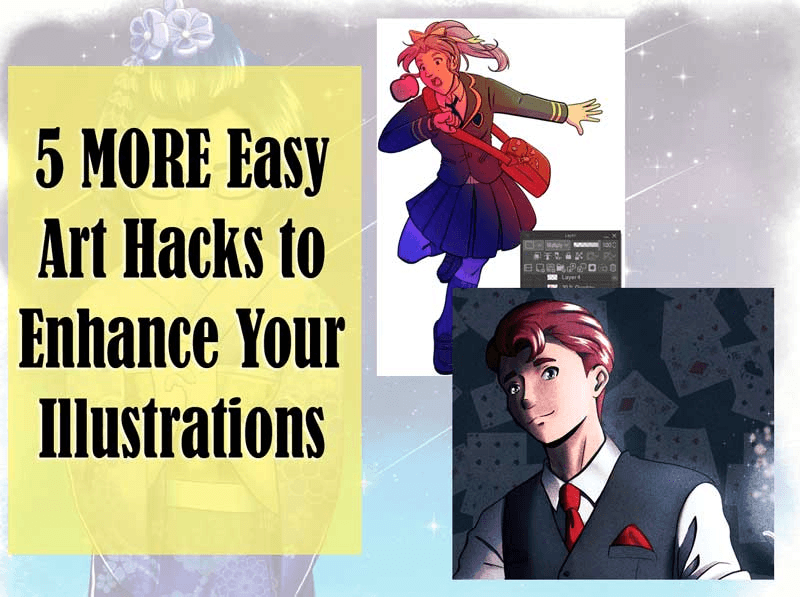4. Painting the character: (1) Eyes and skin
[1] Painting the eyes
I do the painting with the flat colors as the base layers.
I usually choose the [Watercolor] > [Dense watercolor] brush for painting.
For detailed parts, I use the [Pen] > [Mapping pen], then add gradation with the [Watercolor] > [Transparent watercolor] brush.
▼ Tools used: [Dense watercolor] and [Transparent watercolor]
The [Transparent watercolor] sub tool paints in a light color blended with the colors painted underneath.
The [Dense watercolor] sub tool paints in a bold color on top of the colors painted underneath.
Note: The below pictures show the same blue color painted with the [Dense watercolor] and [Transparent watercolor] brushes.
■1. In the “Character” layer folder, I make a new folder titled “Eyes” and move the flat colors for the eyes to here.
I select the flat color layer and go to the [Edit] menu > [Tonal Correction] > [Hue/Saturation/Luminosity] and adjust the brightness of the base layer.
Hint: The [Edit] menu > [Tonal Correction] > [Hue/Saturation/Luminosity] dialog box
To change the brightness of the color, I mostly adjust the [Brightness] slider.
■2. I add a new layer on top of the flat color layer, and paint with the [Watercolor] > [Dense watercolor] brush in a color slightly darker than the base color to paint the pupil and to add shadows at the top of the eye.
■3. Then I make another layer on top of this and set the [Blending mode] to [Overlay]. On this layer I add brighter colors at the top, bottom, and center of the eye.
Hint:
You can change the blending mode of a layer at the top of the [Layer] palette.
While selecting the layer or layer folder that you want to change, click the drop-down list of blending modes and choose the effect you want.
■4. I make a new layer above the line art of the character, and use the [Pen] > [Mapping pen] tool to add highlights to the eyes.
■5. I make a new layer under the “Eyes” layer folder, and paint the white part of the eyes using the [Watercolor] > [Dense watercolor] brush.
■6. I select the layer with the whites of the eyes and click [Lock Transparent Pixel] at the top of the [Layer] palette. Then I paint the shadow on the eyes using a slightly darker color.
Now the eyes are finished.
Hint:
When the [Lock Transparent Pixel] function is on, you can only draw on the parts of the layer that are already drawn. You cannot draw on the transparent pixels. By turning this feature on, I can paint on top of the base colors without going over the edges.
[2] Painting the skin
Next I paint the skin.
First, I make a new layer folder titled “Skin”.
I make a new layer on top of the flat color layer and turn on [Clip at Layer Below], then gradually add more layers on top as I paint. This method is the basic foundation of layered painting.
■1. On this new layer, I use the [Airbrush] tool > [Soft] to color her cheeks and mouth slightly redder than the base color.
Adding color to the joints and places where the skin is thinner also increases the sense of cuteness.
▼ Tool used: [Airbrush] > [Soft]
This sub tool draws soft and airy lines typical of an airbrush. You can increase the brush size for a softer gradation.
■2. I create another layer and set the blending mode to [Multiply]. Using the [Watercolor] > [Dense watercolor] brush, I add shadows for a three-dimensional effect.
I use the [Dense watercolor] brush to shade relatively larger areas such as the neck or her clothes.
I use the [Transparent watercolor] tool to add gradation to shaded areas, as well as to add light shadows to more detailed areas such as the face and fingers.
I wanted the picture to have an overall feeling of calm and make the vivid red of the fall leaves stand out, so I painted shadows with low brightness. I often adjust the color of the shadows after I’ve finished painting everything so that the illustration is well-balanced.
For the depth of the shadows, I chose a high degree of contrast so that the three-dimensional effect could be seen even when viewing from a distance. I used deep shadows where I wanted to strongly indicate a sense of depth, but used light shadows on the face so that the three-dimensional effect wasn’t too strong.
Rather than rough overall shading, I painted certain parts like the eyes and fingertips with detailed shading for a sense of realism.
On the face, to draw the viewer’s gaze to the character’s eyes, I made the shadows of the eyes darker and used light shading on the rest of the face.
■3. I make a new layer and use the [Watercolor] > [Dense watercolor] brush to add the highlights on the skin (parts hit by sunlight), while referring to my rough color sketch, to increase the three-dimensional effect.
■4. I thought that the skin looked a little dark, so I created a new layer just above the flat color layer for the skin and used the [Airbrush] tool > [Soft] to add a lighter color and make the skin look a bit brighter.
■5. I felt that the color for the whites of the eyes didn’t quite match with the skin tone, so I went to the [Edit] menu > [Tonal Correction] > [Hue/Saturation/Luminosity] and adjusted the color to better match.
I also changed the highlight in the eyes and added a highlight on the lips to make them shine.
Now I’ve finished painting the skin.
























Comment